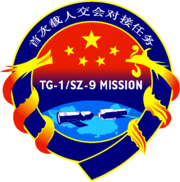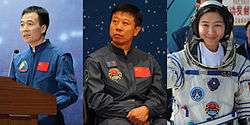Shenzhou 9
 Diagram of Shenzhou-9 (right) docked with Tiangong-1 (left) | |||||
| COSPAR ID | 2012-032A | ||||
|---|---|---|---|---|---|
| SATCAT № | 38461 | ||||
| Mission duration | 13 days | ||||
| Spacecraft properties | |||||
| Spacecraft type | Shenzhou | ||||
| Crew | |||||
| Crew size | 3 | ||||
| Members |
Jing Haipeng Liu Wang Liu Yang | ||||
| Start of mission | |||||
| Launch date | 16 June 2012, 10:37:24 UTC | ||||
| Rocket | Long March 2F | ||||
| Launch site | Jiuquan LA-4/SLS-1 | ||||
| End of mission | |||||
| Landing date | 29 June 2012, 02:01:16 UTC | ||||
| Orbital parameters | |||||
| Reference system | Geocentric | ||||
| Regime | Low Earth | ||||
| Docking with Tiangong-1 | |||||
| Docking date | 18 June 2012, 06:07 UTC | ||||
| Undocking date | 24 June 2012, 03:08 UTC | ||||
| Time docked | 3 days, 21 hours, 1 minute | ||||
| Docking with Tiangong-1 | |||||
| Docking date | 24 June 2012, 04:38 UTC | ||||
| Undocking date | 28 June 2012, 01:22 UTC | ||||
| Time docked | 3 days, 20 hours, 44 minutes | ||||
  (l-r) Jing Haipeng, Liu Wang, and Liu Yang
| |||||
Shenzhou 9 was a manned spacecraft flight of China's Shenzhou program, launched at 18:37:24 CST (10:37:24 UTC), 16 June 2012. Shenzhou 9 was the second spacecraft and first manned spacecraft to dock with the Tiangong 1 space station, which took place on 18 June. The Shenzhou 9 spacecraft landed at 10:01:16 CST (02:01:16 UTC) on 29 June in Inner Mongolia Autonomous Region. The mission's crew included the first Chinese female astronaut, Liu Yang. The next mission was Shenzhou 10, which launched on 11 June 2013.[1]
History
On 12 March 2012, it was announced that the initial crew selection roster for the mission included female astronauts.[2] The crew were unveiled to the press on 15 June. China's first female astronaut would be Liu Yang. Liu was selected ahead of her fellow female astronaut prospect Wang Yaping.[3] This mission also featured the first repeat astronaut, Jing Haipeng, the commander of the mission.[4] Shenzhou 9 was the 9th flight in China's Shenzhou program and the fourth manned spaceflight. The mission's launch was 49 years to the day after that of the first woman in space, cosmonaut Valentina Tereshkova.[3]
Mission preparations
The Shenzhou 9 spacecraft arrived at Jiuquan Satellite Launch Centre in the northwestern Gobi Desert on 9 April 2012 and its carrier rocket, the Long March 2F, arrived on 9 May.[5] On 9 June 2012, the Shenzhou 9 spacecraft and its carrier rocket were rolled out to launch pad.[6] On 12 June 2012 underwent system-wide joint exercises, and final health checks were completed the following day.
Expedition Ceremony
On June 16, 2012, the Expedition Ceremony was held at the Jiuquan Satellite Launch Center. National People's Congress Standing Committee Chairman Wu Bangguo attended the ceremony. The astronauts, Liu Wang, Liu Yang, and Jing Haipeng, rode to the launch tower and turned in the entrance with the assistance of support staff.[7][8]
Mission
The Long March 2F rocket was launched on 16 June 2012 at 10:37 UTC.
Shenzhou 9 docked with China's first space lab Tiangong-1 at 06:07 UTC on 18 June, marking China's first manned spacecraft rendezvous and docking.[9][10] This docking was remotely controlled from a ground station.[11] After about 3 hours, when the pressures inside the vessels were equalized, Jing Haipeng entered into Tiangong-1.[12] Six days later, Shenzhou 9 detached from the station and then redocked manually under the control of crew member Liu Wang, making it the first manual docking for the Chinese program.[11]
Shenzhou 9 landed by parachute in Siziwang Banner, Inner Mongolia on 29 June 2012.[13]
Crew
| Position | Astronaut | |
|---|---|---|
| Commander | Jing Haipeng (景海鹏)[3][14] Second spaceflight First Chinese astronaut to fly more than once in space[3] | |
| Second crewmember | Liu Wang (刘旺)[3] First spaceflight | |
| Third crewmember | Liu Yang (刘洋)[3] First spaceflight First Chinese woman in space[3] | |
Backup crew
The backup crew for the flight was:[15]
| Position | Astronaut | |
|---|---|---|
| First crewmember | Nie Haisheng (聂海胜) | |
| Second crewmember | Zhang Xiaoguang (张晓光) | |
| Third crewmember | Wang Yaping (王亚平) | |
The backup crew later became the prime crew for Shenzhou 10.[16]
Mission timeline
- 9 April 2012
- Shenzhou 9 space capsule arrives at the Jiuquan Satellite Launch Centre [5]
- 9 May 2012
- Long March 2F space launcher arrives at the Jiuquan Satellite Launch Centre [6]
- 9 June 2012
- Launch stack rolled out to the launch pad [6]
- 15 June 2012
- Crew unveiled [3]
- 16 June 2012
- Launch, first woman in space for the Chinese program, first repeat traveller for the Chinese program, first manned mission to a space station for the Chinese program [3]
- 18 June 2012
- First manned rendezvous for the Chinese space program.
- Automated docking with Tiangong-1, first manned docking by the Chinese program [9]
- 24 June 2012
- Shenzhou 9 undocks with Tiangong-1 [11]
- Shenzhou 9 redocks with Tiangong-1, first manual docking by the Chinese space program,[11] second manned docking by the program
- 29 June 2012
- Shenzhou 9 landed in Siziwang Banner, Inner Mongolia.[13]
See also
References
- ↑ "China Completes Tiangong-1 Space Module". 2point6billion.com. 18 August 2010. Retrieved 25 June 2012.
- ↑ 雪萌 (12 March 2012). "Shenzhou-9 may take female astronaut to space: official". China Daily. Retrieved 16 June 2012.
- 1 2 3 4 5 6 7 8 9 Clara Moskowit (15 June 2012). "China Unveils Astronaut Crew, 1st Female Spaceflyer, for Saturday Launch". Space.com. Retrieved 16 June 2012.
- ↑ Reuters (18 June 2012). "China completes successful space docking". London Free Press. Retrieved 25 June 2012.
- 1 2 Mu Xuequan (9 April 2012). "Shenzhou-9 spacecraft delivered to launch centre". Xinhua. Retrieved 16 June 2012.
- 1 2 3 Editor (9 June 2012). "China to launch manned spacecraft this month". The Hindu Business Line. Retrieved 16 June 2012.
- ↑ 神九发射在即航天员已进入飞船舱内 (in Chinese). 中国新闻网. 2012-06-16.
- ↑ "God nine astronauts launch soon enter the spacecraft cabin" (in Chinese). China News net. 2012.
- 1 2 Rui C. Barbosa (18 June 2012). "China's Shenzhou-9 successfully docks with Tiangong-1". NASASpaceflight.com. Retrieved 18 June 2012.
- ↑ YangShuai, ed. (10 June 2012). "China Will Conduct its First Manned Space Rendezvous and Docking Mission——Shenzhou 9 spaceship has been transferred to the launch site and ready for launch in Mid-June". CMSE - China Manned Space Engineering.
- 1 2 3 4 Associated Press (24 June 2012). "Chinese spacecraft Shenzhou 9 makes first manual docking with space module". The Guardian. Retrieved 25 June 2012.
- ↑ "China successfully completes space docking". China Daily. 19 June 2012.
- 1 2 "China's first female astronaut touches down". Australian Broadcasting Corporation. 29 June 2012. Retrieved 29 June 2012.
- ↑ "神九航天员乘组亮相_国内新闻_环球网". China.huanqiu.com. Retrieved 25 June 2012.
- ↑ Morris Jones (3 April 2013). "Shenzhou's Shadow Crew". Space Daily.
- ↑ "Astronauts of Shenzhou-10 mission meet press". Space Daily. 11 June 2013.
External links
| Wikimedia Commons has media related to Shenzhou-9. |
- Xinhua News, China launches Shenzhou 9 news archive (accessed 2012-06-26)
- People's Daily Online, Shenzhou-9 Panoramic Report news archive (accessed 2012-06-26)
- CNTV.cn, Shenzhou 9 video archive (accessed 2012-06-26)
- Spaceflight101, Shenzhou 9 Mission Updates (accessed 2012-06-26)
- zarya.info, Shenzhou 9 Mission Diary and Analyses